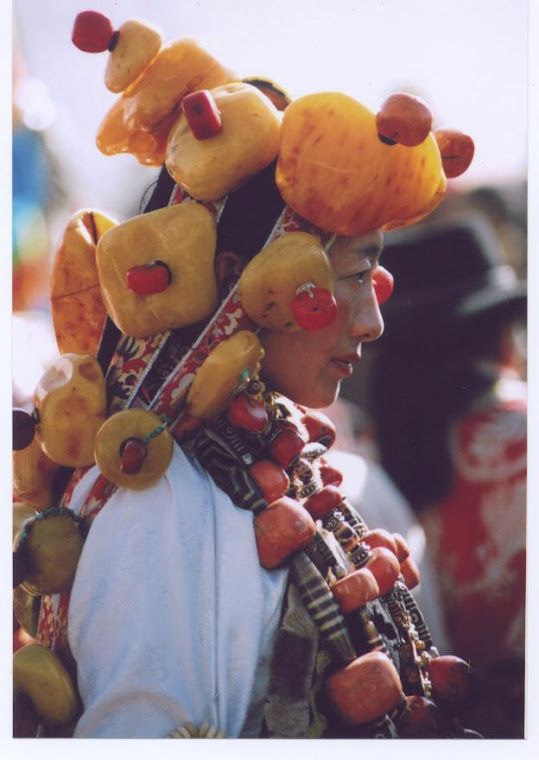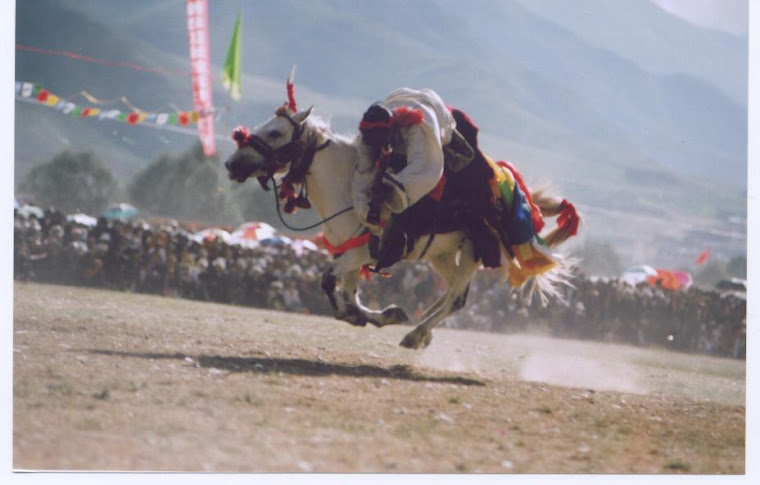2008/10/22
Brief History of Tibet
A brief account of Tibet, its origin, how it grew into a great military power and carved for itself a huge empire in Central Asia.
Five hundred years before Buddha Sakyamuni came into this world i.e., circa 1063 B.C., a semi-legendary figure known as Lord Shenrab Miwo reformed the primitive animism of the Shen race and founded the Tibetan Bon religion. According to Bonpo sources there were eighteen Shangshung Kings who ruled Tibet before King Nyatri Tsenpo. Tiwor Sergyi Jhagruchen was the first Shangshung King.
Shangshung, before its decline, was the name of an empire which comprised the whole of Tibet. The empire known as Shangshung Go-Phug-Bar-sum consisted of Kham and Amdo forming the Go or Goor, U and Tsang forming the Bar or Middle, and Guge Stod-Ngari Korsum forming the Phug or Interior.
As the Shangshung empire declined, a kingdom known as Bod, the present name of Tibet, came into existence at Yarlung and Chongyas valleys at the time of King Nyatri Tsenpo, who started the heroic age of the Chogyals (Religious Kings). Bod grew until the whole of Tibet was reunited under King Songtsen Gampo, when tha last Shangshung King, Ligmigya, was killed.
The official Tibetan Royal Year of the modern Tibetan calendar is dated from the enthronement of King Nyatri Tsenpo in 127 B.C. This lineage of Tibetan monarchy continued for well over a thousand years till King Tri Wudum Tsen, more commonly known as Lang Darma, was assassinated in 842 A.D.
Most illustrious of the above kings were Songtsen Gampo, Trisong Detsen and Ralpachen. They are called the Three Great Kings.
The Great King Songtsen Gampo with his Nepalese and Chinese Queen
During the reign of King Songtsen Gampo (629-49) Tibet became a great military power and her armies marched across Central Asia. He promoted Buddhism in Tibet and sent one of his ministers and other young Tibetans to India for study. He first took a Tibetan princess from the Shangshung King as his wife and then obtained a Nepalese consort. After invading the Chinese Empire he also obtained a Chinese princess as one of his wives. The two latter wives have been given prominence in the religious history of Tibet because of their services to Buddhism.
During the reign of King Trisong Detsen (755-97) the Tibetan Empire was at its peak and its armies invaded China and several Central Asian countries. In 763 the Tibetans seized the then Chinese capital at Ch'ang-an (present day Xian). As the Chinese Emperor had fled, the Tibetans appointed a new Emperor. This memorable victory has been preserved for posterity in the Zhol Doring (stone pillar) in Lhasa and reads, in part:
"King Trisong Detsen, being a profound man, the breadth of his counsel was extensive, and whatever he did for the kingdom was completely successful. He conguered and held under his sway many districts and fortresses of China. The Chinese Emperor, Hehu Ki Wang and his ministers were terrified. They offered a perpetual yearly tribute of 50,000 rolls of silk and China was obliged to pay this tribute
It was during his time that Samye, the first monastery in Tibet, was founded by Guru Padmasambhava, who also established the supremacy of Buddhism and coverted the indigenous deities into guardians of the Dharma. King Trisong Detsen also expelled the Chinese monk (Hoshang) and banished the Chinese Chan school of Buddhism from Tibet forever and adopted the Indian system. He also declared Buddhism as the state religion of Tibet.
During the reign of King Ralpachen (815-36) the Tibetan armies won many victories and in 821-2 a peace treaty was concluded with China. The inscription of the text of the treaty exists in three places: One outside the Chinese Emperor's palace gate in Ch'ang-an, another before the main gate of Jokhang temple in Lhasa and the third on the Tibetan-China border at Mount Guru Meru. Eminent Tibetan scholars, Kawa Paltsek and Chogru Lui Gyaltsen, worked with Indian scholars, invited them to Tibet and prepared the first Sanskrit-Tibetan lexicon called the Mahavyutpatti.
In 838 King Ralpachen's brother, Tri Wudum Tsen, ascended the throne. He tried to reinstate the Bon religion and persecuted the Buddhists. After his assassination by a Buddhist monk the kingdom was divided between his two sons. With warring princes, lords and generals contending for power the mighty Tibetan Empire disintegrated into many small princedoms and a dark period fell over Tibet during 842-1247.
In 1073 Konchog Gyalpo founded the Sakya monastery. His son and successor, Sakya Kunga Nyingpo, formulated the tantric traditions of the great scholars Marpa and Drogme and founded the Sakya sect. The Sakya lamas grew in power and from 1254 to 1350 Tibet was ruled by a succession of 20 Sakya lamas. The Mongols, who invaded many countries of Europe and Asia, also invaded Tibet and reached Phenpo, north of Lhasa. However, Prince Godan, the ruling Khan, was converted to Buddhism by Sakpa Kunga Gyaltsen, popularly known as Sakya Pandita, and the invading force was withdrawn. The next Khan, Kublai, was also converted to Buddhism by Sakya Pandita's nephew and successor, Sakya Phagpa. In return, Kublai Khan gave recognition of full sovereignty over "the three provinces of Tibet : U-Tsang, Dhotoe and Dhome" to Sakya Phagpa.
The influence of the Sakya priest-rulers gradually declined after the death of Kublai Khan in 1295. In 1358 the province of U (Central Tibet) fell into the hands of the Governor of Nedong, Changchub Gyaltsen, a monk of the Phamo Drugpa branch of Kagyud school, and for the next 86 years, eleven Lamas of the Phamo Drugpa lineage ruled Tibet.
But, after the death of Drakpa Gyaltsen, the fifth Phamo Drugpa ruler, in 1434, power passed into the hands of the Rinpung family who were related to Drakpa Gyaltsen by marriage. From 1436 to 1566 the heads of the Rinpung family held power.
Meanwhile, Tsongkhapa Losang Dragpa, one of the greatest scholars of Tibet, was born in 1357. He founded Gaden, the first Gelugpa monastery, in 1409 and began the Gelug lineage.
The Great Ganden Monastery
During the first decade of the 16th century, Tseten Dorje, a servant of the Rinpung family, with the help of some local tribes and Mongols, managed to gain control of Shigatse and the surrounding regions of Tsang province. From 1566 to 1642 Tseten Dorje and his two successors ruled Tibet with the title of Depa Tsangpa.
Sonam Gyatso, born in 1543, emerged as a scholar of great spiritual and temporal wisdom. He became the spiritual teacher of the Phamo Drugpa ruler, Drakpa Jungne. He was the Abbot of Drepung monastery and the most eminent lama of that time. He provided extensive relief to the Kyichu flood victims in 1562, founded Lithang Monastery in 1580 and Kumbum Monastery in 1582. He also successfully mediated between the various warring factions in Tibet. He converted Altan Khan to Buddhism and the latter conferred on him the title Dalai Lama meaning "Ocean of Wisdom" in 1578. As Sonam Gyatso was third in his line, he became the Third Dalai Lama, the title being posthumously conferred on his two previous incarnations.
A
close spiritual relationship developed between Tibet and Mongolia. The Gelugpa sect grew stronger and gradually eclipsed the waning Sakya authority.
In 1642, the Fifth Dalai Lama, Ngawang Lozang Gyatso, assumed both spiritual and temporal authority over Tibet. He established the present system of the Tibetan Government, known as the Ganden Phodrang, "Victorious Everywhere".
Subscribe to:
Post Comments (Atom)




















No comments:
Post a Comment